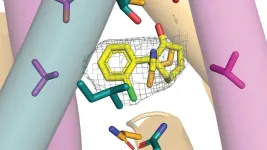(Press-News.org) Several cardiovascular risk factors, such as advanced age and smoking history, are prevalent among lung cancer patients at the time of the diagnosis and increase their risk of future heart disease, according to a new study being presented at ACC’s Advancing the Cardiovascular Care of the Oncology Patient course. Comprehensive assessments are needed in this vulnerable group to improve survival outcomes and quality of care for cancer patients.
Heart disease and cancer are the leading causes of death in the United States. Smoking is a shared risk factor for lung cancer and cardiovascular disease, and lung cancer patients have an amplified mortality rate with the presence of existing cardiovascular disease. Some treatments for lung cancer, such as radiation therapy, could elevate the risk of heart disease for these patients.
“The overall goal of the study was to determine the presence of traditional cardiac risk factors in this specific cancer population and to determine the usefulness of available CT imaging in the identification of atherosclerosis present at the time of cancer diagnosis,” said Christopher Malozzi, DO, lead author of the study and director of cardio-oncology services at the University of South Alabama Frederick P. Whiddon College of Medicine. “Recognition of cardiac risk factors and atherosclerosis allows for earlier treatment interventions and risk factor modification in these patients.”
The study assessed 276 lung cancer patients at a cancer center for existing atherosclerosis on staging computed tomography (CT) scans. Atherosclerosis is when plaque builds up in the arteries, potentially blocking blood flow and leading to cardiovascular complications. Data was also collected on their systolic blood pressure), diastolic blood pressure, pulse pressure, body mass index, age, sex, race, smoking status and type of lung cancer. The results showed that 77.9% of the participants had detectable atherosclerosis on CT scans. Additionally, the data revealed that 47.8% of the patients had systolic blood pressure greater than or equal to 130 mmHg and 38% had diastolic blood pressure greater than or equal to 80 mmHg. Systolic blood pressure is the top number on a blood pressure reading and indicates the pressure or force in the arteries when the heart is beating, while the diastolic number is the lower number and indicates the pressure in the arteries in between beats. Normal blood pressure should be below 120 mmHg/80 mmHg. Overall, 27.2% of the participants were obese and 88.8% were current or former tobacco users.
“Smoking was by far the most prominent cardiac risk factor in this group. This was followed by advancing age, hypertension and obesity,” Malozzi said. Although, the study lacked sufficient data to adequately assess the impact of high cholesterol or diabetes, these risk factors need to also be considered due to their relationship with cardiovascular disease, according to Malozzi.
Each patient underwent imaging for evaluation and staging of their lung cancer, which included a CT scan of the chest. Additionally, these CT scans could be used to detect atherosclerosis of the coronary arteries in the form of calcification within the blood vessels.
“This study suggests it may be reasonable to consider concurrent coronary calcium scoring on imaging obtained for lung cancer staging or screening to aid in identification of atherosclerosis and earlier intervention such as lifestyle, diet and cardiac risk factor modification education. The use of imaging already available may also reduce the need for additional testing in these patients and cut down overall health care costs,” Malozzi said.
The study group performed a similar analysis using CT scans to examine atherosclerosis in gynecological cancer patients entering treatment. The study found that atherosclerosis was present in nearly one-third of the study participants, indicating a high prevalence of heart disease. The cardiovascular disease risk factors examined are largely modifiable. The results of this study will also be presented during ACC’s Advancing the Cardiovascular Care of the Oncology Patient course.
About ACC’s Advancing the Cardiovascular Care of the Oncology Patient Course
Taking place on February 14-16, 2025, in Washington, the ACC’s Advancing the Cardiovascular Care of the Oncology Patient conference is an interdisciplinary and inter-specialty conference designed to provide clinicians with the tools needed to improve the cardiovascular care of cancer patients in everyday practice. Learn more.
The American College of Cardiology (ACC) is the global leader in transforming cardiovascular care and improving heart health for all. As the preeminent source of professional medical education for the entire cardiovascular care team since 1949, ACC credentials cardiovascular professionals in over 140 countries who meet stringent qualifications and leads in the formation of health policy, standards and guidelines. Through its world-renowned family of JACC Journals, NCDR registries, ACC Accreditation Services, global network of Member Sections, CardioSmart patient resources and more, the College is committed to ensuring a world where science, knowledge and innovation optimize patient care and outcomes. Learn more at www.ACC.org or follow @ACCinTouch.
###
END
A study finds that 65.8% of adults surveyed had low trust in their health care system to use artificial intelligence responsibly and 57.7% had low trust in their health care systems to make sure an AI tool would not harm them.
The research letter was published in JAMA Network Open.
Adults who had higher levels of overall trust in their health care systems were more likely to believe their providers would protect them from AI-related harm.
The letter, authored by Jodyn Platt, Ph.D., of the Department of Learning Health Sciences at University of Michigan Medical School and Paige Nong, Ph.D., of the University of Minnesota School of Public Health comes from survey of a nationally ...
Digital@INSEAD is hosting a free TECH TALK X webinar “The Dual Race to AI & Global Leadership” on Wednesday, 19 February 2025 7.00 am ET / 1.00 pm CET (Duration: 60 min).
The TECH TALK will be featuring a discussion between Tim Gordon (MBA’00D), Partner, Best Practice AI and Theos Evgeniou, INSEAD Professor of Technology & Business and Director of Executive Programs in AI.
Tim, an INSEAD alumnus with over 20 years of international experience in digital transformation, global strategy and innovation, will join Theos to explore the two critical AI races reshaping our world: ...
Ketamine has received a Hollywood makeover. It used to be known as a rave drug (street name special K) and cat anesthetic. However, in recent years, some doctors have prescribed ketamine to treat conditions from post-traumatic stress disorder to depression. “The practice is not without controversy,” notes Cold Spring Harbor Laboratory (CSHL) Professor Hiro Furukawa.
‘Should we give a hallucinogen to patients in compromised mental states?’ wonder ketamine’s skeptics. The controversy came to ...
About The Study: The findings of this cross-sectional study of Black and white women with breast cancer suggest that perceived stress, perceived inadequate social support, perceived racial and ethnic discrimination, and neighborhood deprivation were associated with deleterious alterations to the systemic and tumor immune environment, particularly for Black women. Understanding biology as a possible mediator of cancer health disparities may inform prevention and public health interventions.
Corresponding Author: To contact ...
About The Study: This cohort study of Finnish children and adolescents found that higher physical activity and lower screen time from childhood were associated with perceived stress and depressive symptoms in adolescence. These findings emphasize reducing screen time and increasing physical activity to promote mental health in youth.
Corresponding Author: To contact the corresponding author, Eero A. Haapala, PhD, email eero.a.haapala@jyu.fi.
To access the embargoed study: Visit our For The Media website at this link https://media.jamanetwork.com/
(doi:10.1001/jamanetworkopen.2024.60012)
Editor’s Note: Please see the ...
At $144 billion, type 2 diabetes was the most expensive single health condition.
Emergency department care had the fastest growth.
SEATTLE, Wash., Feb. 14, 2025 – Researchers present the most comprehensive study on U.S. health care spending and variations across 3,110 counties by four payers, 148 health conditions, 38 age/sex groups, and seven types of care. That’s according to the newest and most extensive studies published in JAMA and JAMA Health Forum today.
As part of this study, researchers ...
About The Study: Broad variation in health care spending was observed across U.S. counties. Understanding this variation by health condition, sex, age, type of care, and payer is valuable for identifying outliers, highlighting inequalities, and assessing health care gaps.
Corresponding Author: To contact the corresponding author, Joseph L. Dieleman, PhD, email dieleman@uw.edu.
To access the embargoed study: Visit our For The Media website at this link https://media.jamanetwork.com/
(doi:10.1001/jama.2024.26790)
Editor’s ...
About The Study: In this cross-sectional study, variation in health care spending among U.S. counties was largely related to variation in service utilization. Understanding the drivers of spending variation in the U.S. may help policymakers assess the allocation of health care resources.
Corresponding Author: To contact the corresponding author, Joseph L. Dieleman, PhD, email dieleman@uw.edu.
To access the embargoed study: Visit our For The Media website at this link https://media.jamanetwork.com/
(doi:10.1001/jamahealthforum.2024.5220)
Editor’s ...
Digital@INSEAD is hosting a free INTHECASE webinar, “Scaling Affordable Healthcare: Balancing Purpose, Innovation & Growth” on Thursday, 20 February 2025 at 9.00 am ET / 3.00 pm CET (60 min).
Register and join the webinar for an engaging discussion on Access Afya’s journey to scale its affordable healthcare model while staying true to its mission of serving underserved communities.
Explore how the company:
Balances mission and growth
Navigates the complexities of scaling up
Leverages technology and data to improve care delivery
With a proven business model in Kenya, ...
The body regulates its metabolism precisely and continuously, with specialised cells in the pancreas constantly monitoring the amount of sugar in the blood, for example. When this blood sugar level increases after a meal, the body sets a signal cascade in motion in order to bring it back down.
In people suffering from diabetes, this regulatory mechanism no longer works exactly as it should. Those affected therefore have too much sugar in their blood and need to measure their blood sugar level and inject themselves with insulin in order to regulate it. This is ...


